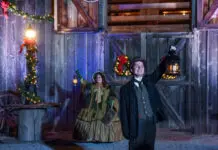College Basketball
Oklahoma has had plenty of basketball excitement this year already with the OKC Thunder’s big push for the NBA championship. But for those fans professing to “only watch college basketball,” the year is just winding up all over again as men’s and women’s ball teams battle to see who will end up on the grid headed for the merry month of March Madness. Long-term, fans watch their favorite teams and players to see their chances for the finals or a conference title, or at least a good season. All the while, they also watch the competition to keep an eye on players rising in the ranks. Pro teams are watching, too, for rookies with potential to turn a team around. When it comes down to it, everyone will have eyes on college basketball in November. Whether you’re for OU, OSU, TU, ORU or any other team, consider yourself drafted into a national, fabulous obsession. Want to see more? Check out these websites for rosters, schedules and the scoop:
www.soonersports.com
www.orugoldeneagles.com
www.tulsahurricane.com
www.okstate.com
Guts and Glory: An Evening with Anthony Bourdain
Not all goodbyes are sad. That’s not to insinuate that rock-n-roll foodie Anthony Bourdain has worn out his welcome on the food culture front, yet after nine seasons of his Travel Channel hit show No Reservations, Bourdain has bowed out of the show that brought him widespread fame for his unabashed (and occasionally unfiltered) enthusiasm for travel, people and food, particularly of the “meat in tube form” variety. Does he seem disappointed? Ask him when he arrives at the Rose State College Performing Arts Theatre in Midwest City for a stop on his Guts and Glory Tour. As his other Travel Channel show, The Layover, winds down, too, we’re not sweating the finale, not with Bourdain set to host a new show on CNN on cuisine and culture. Call it his next course. For tickets to Guts and Glory, go to www.myticketoffice.com
The Red Dot Art Auction & Sale
Friday, Nov. 9, at 7 p.m.
The Individual Artists of Oklahoma can always be counted on to provide art exhibits of excellence, ingenuity and vision. So, what separates the Red Dot Art Auction & Sale from other shows at the IAO Gallery in Oklahoma City? Food. There’s nothing like artwork on the silent auction block with a side of tasty morsels from some of the most exciting restaurants and establishments in town. Add to the blend great drinks and a first-rate scene of personalities and talents – that’s the formula for a fun, successful night that also raises money for the gallery. Look for it at 706 W. Sheridan, from 7-11 p.m. Friday, Nov. 9. The silent auction will feature the artwork of nearly 100 Oklahoma artists, including Marilyn Artus, Dylan Bradway, J. Don Cook and Romy Owens. Tickets are $25. Go to www.iaogallery.org for all the details.
Tulsa Veterans Day Parade
Monday, Nov 12, at 11 a.m.
U.S. veterans are honored in a big way at the annual Veterans Day Parade in downtown Tulsa. Beginning at 8:30 a.m., participants will line-up behind the parade route start at South Boston Avenue and Third Street. The parade (which begins at 11 a.m.) will go west on Third Street and turn south on Boulder Avenue. The parade turns back east on Seventh Street then north on Boston Avenue before making its final turn (east on Sixth Street) to the end of the route at Sixth Street and South Detroit Avenue. School groups will be there to watch along with many others and to applaud and support the men and women who have served in the armed forces riding in floats and cars along with marching bands, ROTC groups, veterans organizations and much more. To learn more or see a parade route, visit www.vfwpost577.org for other details.
Aerosmith
Thursday, Nov. 8, at 7:30 p.m.
Aerosmith has acquired such an esoteric status of rock stardom that, anymore, it’s easy to overlook its members having individual lives and personal histories – at least in the “normal” sense. When lead guitarist Joe Perry, however, reportedly announced a few years ago that the band was looking to replace lead singer and expert scarf stylist Steven Tyler, the story-go-round picked up speed looking for reasons from Tyler’s injuries to a diva temperament. Thank guitar heavens that the band seems to be square (for Aerosmith, that is) again and on the road for the album, Music from Another Dimension, released next month. The band plays the Chesapeake Energy Arena, 100 W. Reno Ave., at 7:30 p.m. Thursday, Nov. 8. Cheap Trick opens, and tickets are $52.50-$152.50. As for the rumors, keep them. Go to www.chesapeakearena.com for more.
splitting time
Open through Nov. 24
The Tulsa Artists’ Coalition Gallery is a small block of space in the Brady Arts District frequently filling to capacity with visitors on opening nights. When guests experience Aaron Higgins’ Splitting Time: A Digital Media Exhibit, they may find that space expanded beyond the walls. Splitting Time splices and dices in this multimedia installation of images on monitors, camera captures and computer processes that fragment time and images before reordering everything into new compositions. The assistant professor at the University of Tulsa School of Art calls it the creation of a “colorful mosaic of time” and a mirror of time’s cyclical nature. It blows our minds, too. The exhibit runs through Nov. 24. For more, go to www.tacgallery.org.
Wings Over Tulsa & Hangar Dance
Saturday, Nov. 10
It’s time again to swing your partner … over your shoulder, up in the air and across the floor. The Spirit of Tulsa Squadron of the Commemorative Air Force hosts its big day that begins with planes and ends with a 1940s USO-themed hangar dance where swing dance devils show off their best moves. Wings Over Tulsa runs 9 a.m.-3 p.m. Saturday, Nov. 10, at Tulsa Technology Center’s Riverside Campus at 801 E. 91st St. near Riverside/Jones Airport. World War II veterans are offered rides in vintage aircraft. Donations for fuel expenses will be accepted. That night, the hangar dance opens from 5-10 p.m. The buffet dinner will be served from 5-6 p.m. followed by free swing dance lessons from 6-7 p.m. Couples let loose on the dance floor to live big band music from 7-10 p.m. Tickets for the dance are $20 each and do not include dinner (buffet is pre-ordered). For more, go online to www.caftulsa.org.
Theatre Pops' November
Thursday-Sunday, Nov. 8-11
The general election is over, but the lingering political pangs of the much-awaited day will be felt for months to come. When the numbers are made “official,” there will be a winner and a loser. Charles Smith, however, is a loser well before the ballots have been cast as the corrupt, inept occupant of the Oval Office in David Mamet’s dark humored November. Theatre Pops brings President Smith and his shady staff to the Tulsa Performing Arts Center’s Liddy Doenges Theatre, 101 E. Second St., for three performances at 8 p.m. Nov. 8-10 (Thursday-Saturday) and an afternoon showing at 2 p.m., Sunday, Dec. 11. If politics had the proverbial penny for every time someone called it for the wicked game it can be, the U.S. could suddenly find itself solvent. Tickets are $15 and available at www.myticketoffice.com. For more on company, go to www.facebook.com/theatrepops.
2012 State of Creativity Forum
Tuesday, Nov. 13, 7 a.m.-5:30 p.m.
This year’s State of Creativity Forum asks an essential question: Do you feel creative? Whether your answer is “yes” or “no,” an event like the State of Creativity Forum was made to inspire all. The day-long event will be held at the Cox Convention Center, 1 Myriad Gardens, Oklahoma City, and it features a roster of speakers and innovators of their fields of business, the arts, government, technology and more. Sir Ken Robinson, renowned for creative development in education and economics, and Peter Diamandis, CEO of the X PRIZE Foundation promoting commercial space innovations, are the day’s keynote speakers. The day begins with an opening session and keynote event with Robinson. It continues with seminars and workshops plus Diamadis’ address at the luncheon. Come and learn and contribute. Registration is $150 for the full day ($95 for students). More details are available at www.stateofcreativity.com.






















